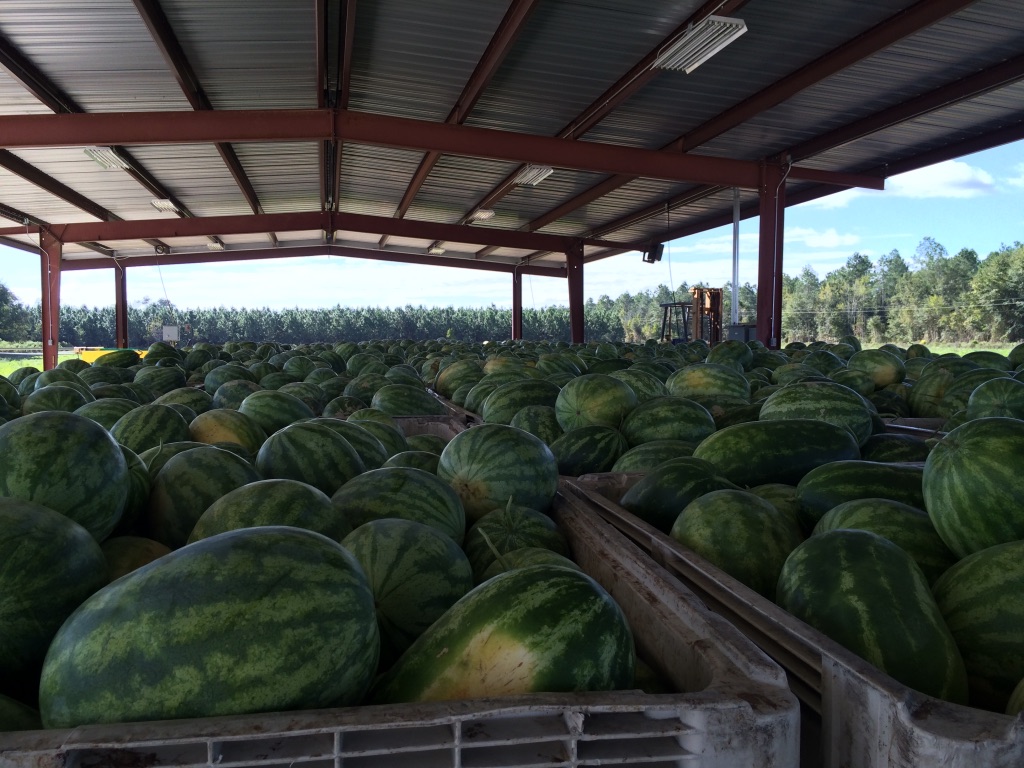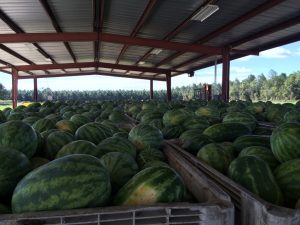The 2018 Florida watermelon season posed challenges for most growers that resulted in lower yields and higher fruit prices.
Bob Hochmuth, regional specialized Extension agent for vegetable crops at the University of Florida (UF) Institute of Food and Agricultural Sciences North Florida Research and Education Center in Suwannee Valley discussed Florida’s 2018 watermelon season. He addressed the challenges growers faced, the prices they received and a new bacterial disease that was discovered this year.
DEMAND DRIVES PRICES
Due to rainfall and disease pressure, growers had lower yields than expected in Central and South Florida. This led to very high demand during the watermelon harvesting season in North Florida, and specifically the Suwannee Valley.
The Suwannee Valley region has about one-third of Florida’s total watermelon acreage. This year, reduced yield south of this area meant that prices were much stronger at the beginning of the season as a result of the pipeline of watermelons not being quite filled. There was an unusually high price for the fruit during most of the season.
High prices were necessary for farmers to be profitable this year due to the challenges that they had early in the season with freeze events, the need to replant, and some unusually rainy periods during the growing season that increased the incidences of disease.
“It was a very expensive crop for us to manage,” said Hochmuth. “And because prices were higher than normal, it ended up being a reasonably successful year for the most part as long as growers were able to get a good yield out of their fields.”
The main influencers of this year’s market price had to do with the supply being lower than normal coming into the northern part of the state. Since there was a low supply, the demand was higher. Therefore, the price held a little higher and stronger than it normally would.
Typically, the price of seedless watermelons in the Suwannee Valley area would be expected to be 14 to 18 cents per pound. For much of the season this year, growers were able to get a higher price per pound than the normal price. Growers received 20 cents per pound or higher.
Growers needed to receive a higher price per pound than normal to be able to recoup the high investment for the crop. If the price had been a normal value this year, it would’ve been a tough year for Florida watermelon growers.
WEATHER CHALLENGES
The main factors that affected price this year were weather related. “One was a late freeze after the crop had been planted, moving the crop in this area a little later than it would’ve been coming to market,” explained Hochmuth. “Then, the second one was the high level of rainfall during the entire spring season. This rain impacted the southern part of the state where they were already in production. In the Suwannee Valley area, we also got additional rainfall that made disease pressure much higher. We had long, extended periods of rainy weather that most of the fungal and bacteria diseases love. So, it was an extended period of time where growers had a challenge of managing those diseases. Therefore, both fungal and bacterial diseases created some yield reduction overall.”
OTHER PRODUCTION AREAS
Once the harvest season is finished in Florida, the industry moves north into Georgia, South Carolina, Missouri, Indiana and other areas. “In those areas, the harvest season has been met with a much lower price and a much more challenging market because there is more supply than there is demand at this point,” stated Hochmuth. He says it is difficult to predict what will happen next year due to fluctuations within the marketplace over the course of the season.
NEW DISEASE
This year, there was a discovery of what could be a new bacterial disease. UF researchers began work in mid-July to learn more about the disease and find solutions for growers as soon as possible. The research team wants to help growers manage the problem before it becomes a bigger issue next year. To begin to figure out various management strategies for this new disease, the researchers are establishing trials at the North Florida Research and Education Center.
This article was featured in the September issue of VSCNews magazine. To receive future issues of VSCNews magazine, click here.
Share this Post











